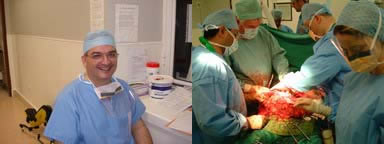 |
 |
|
|
All images, illustrations & flash animation are copyrighted to Deya Marzouk, unless stated otherwise. Copy is prohibited without written permission. Innovative techniques mentioned in this web site were all devised by Deya Marzouk. Please Credit Deya Marzouk if any material is copied from here (with prior permission only) |
Seventy percent of colorectal cancer patients present with potentially curable disease. About 35 % of these subsequently develop recurrent disease. This mainly affect the liver (44%) & lungs (21%), but may also occur locally or in the regional nodes and omentum.
Local recurrence of colorectal cancer is catastrophic for the patient and is characterized by severely diminished quality of life. Patients may experience intractable pelvic or sciatic pain; bleeding, severe obstructed defaecatory symptoms, intestinal obstruction; dysuria and urinary tract dysfunction; and chronic pelvic sepsis. Surgery offers The only hope for cure and the best hope for control of symptoms. The literature suggest that 5 year survival would be in the range of 25-30%
Study |
No. |
Mortality |
Morbidity |
5 Y survival |
Local re-recurrence |
Suzuki 1995 |
224 |
0% |
6% |
34% |
47% @ 5Y |
Garcia-Aguilar 2001 |
64 |
|
25% |
35% |
33% |
Bozzetti 1997 |
45 |
|
N/A |
19% in 21 pts |
N/S |
Wanebo 1999 |
61 |
5.4% |
|
31% |
|
Yamada 2001 |
60 |
|
|
Overall 18% (38%, 10%, 0%) |
|
Yamada 2002 |
42 |
|
60% |
22.9% |
N/S |
Lopez-Kostner 2001 |
43 |
|
19% |
32.2% |
28% |
Ogunbiya 1997 |
14 |
|
N/A |
86% @ 2Y |
7% |
Rodel 2000 |
28 |
|
44% |
82% @ 3Y |
18% |
Miller 2000 |
40 |
|
43% |
Median 42 M |
N/S |
All patients with suspected recurrence should have CT of chest, abdomen & pelvis (or MRI, when appropriate) as well as PET scan to assess the presence of metastatic disease. Recurrence is suspected clinically, by a rising CEA or on routine scanning such as US or CT.
Presence of metastatic disease is not an absolute contraindication to resection of local / intra-abdominal recurrence. Some metastatic disease (especially in the liver) may be resectable, some may respond to other systemic treatment and in other situations it is obvious that local disease will overwhelm the patient if left untreated while distant disease may still be at early stages. Judgment is important of what is right for individual patients
Perhaps the most useful indicator for resectability is clinical examination and or examination under anaesthesia by experienced hands. However, even experienced hands may get it wrong and that is why preoperative CT & MRI are vital. When in doubt, I rely more on clinical assessment (if feasible in an accessible location) and occasionally only a laparotomy can tell.
There is no set technique separating surgery for recurrent colorectal cancer from surgery for advanced colorectal cancer. Both require similar patience and skills. The latter not only include operative dexterity and wide experience in abdominal surgery (GI, Hepatobiliary, pancreatic, urology & gynaecology) but also sound ability at operative planning, problem solving of unusual situations and familiarity of reconstructive procedures that may involve organs outside the GI tract.
As a general rule the operation starts by assessment of the tumour mobility (along with other organs that can be sacrificed to achieve clear margins). Next a trial dissection is carried out before being committed to division of major blood supply to parts of bowel or other organs (which may force the surgeon to debulk the tumour rather than remove it with clear margins). Once it seems that resection is feasible, then dissection is carried out if at all possible similar to a primary resection (i.e. following the steps normally undertaken in such operation). This is not always possible and more commonly the surgeon has to keep on changing his plan of attack, usually coming from different directions and leaving the most difficult part till later. This normally pays off as dissection from one direction may facilitate dissection from another direction. I always tell trainees this is similar to encirclement tactics used by tank formations! One has to stop from time to time, take stock and make sure the resection still makes sense and how best to launch the next attack (on the tumour area). When the tumour involves much of the small bowel (as in the following flash slide show), much judgment is needed to save intestinal length and still resect the tumour with clear margins. This invariably needs some adhesiolysis and multiple resections and anastomosis. Early assessment of whether the main stem of the superior mesenteric is involved in any way is vital. If a part of the abdominal wall is lost as part of the resection, reconstruction may need a vicryl mesh to cover the intestine and bridge the gap in the peritoneum & posterior rectus sheath (the omentum is almost invariably completely resected in such cases), followed by prolene mesh reconstruction of the defect in the muscles and anterior rectus sheath.
This is a controversial subject. Many surgeons would only attempt to resect the disease if it is potentially curative. Others firmly believe that the misery and the very poor quality of life associated with local & regional recurrence justifies attempts at resections in many more patients with a palliative intent. I belong to the latter group. It is essential however that both the surgeon and patient have reasonable expectations and continuously balance the expected benefits in terms of palliation & quality of life against the inherent risks of such surgery. This type of surgery should never be taken lightly, but surgeons experienced enough (and trained) in abdominal cancer surgery should not shy away from offering this type of surgery because of the tremendous positive impact on patients' quality of life in these situations.
Numbers vary throughout the years, but they are increasing because of increased experience and increased referrals from other surgeons & oncologists. I operated on 5 during 2005 alone (3 of these were not included in the figures below). Our figures suggest that about 5% of colorectal cancer patients would be candidates for such surgery
We looked retrospectively at patients with recurrent colorectal cancer that I treated at QEQM between mid 1998 and mid 2005. We identified 52 patients with possible recurrence (from our patients and other surgeons). Only 34 could be analysed, the rest were ‘untraceable’ or ‘notes lost in system, archived etc.
Twenty three patients had confirmed local, nodal, omental or other intra-abdominal recurrence (7.2% of 319 colorectal cancer operations), detected at a median of 12 months following original surgery. Eleven had no recurrence. Six were Inoperable (advanced widespread disease), while 17 patients were operable (5.3%). Of these 14 proceeded to operation (4.4%), most as enbloc resections. Sixty four percent of organs other than the colon or rectum removed at surgery had malignant infiltration. The circumferential margins were free of disease in 86%. Asymptomatic patients stood a much higher chance of potentially curative resections with clear margins.
We have not fully analysed the survival figures, but preliminary results showed extended survival and more importantly there was tremendous improvement in the quality of life of symptomatic patients.
 |
 |
|